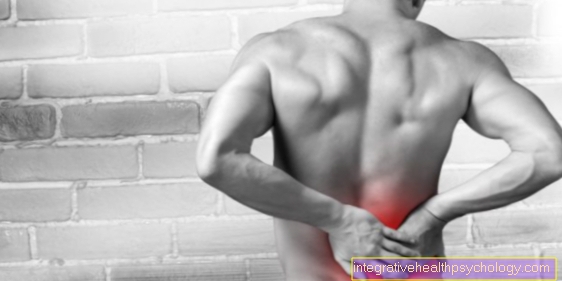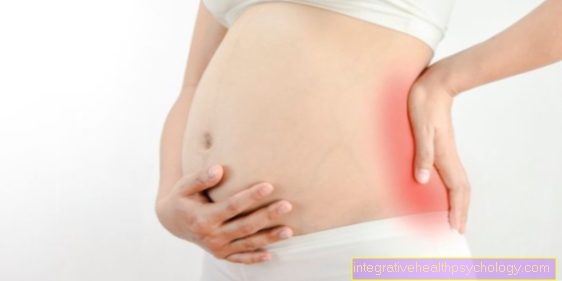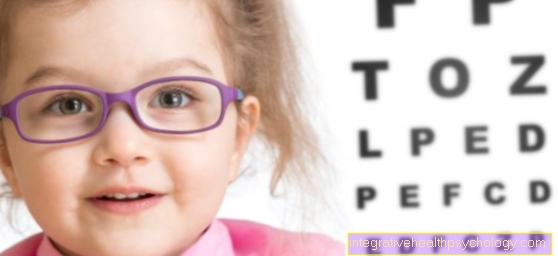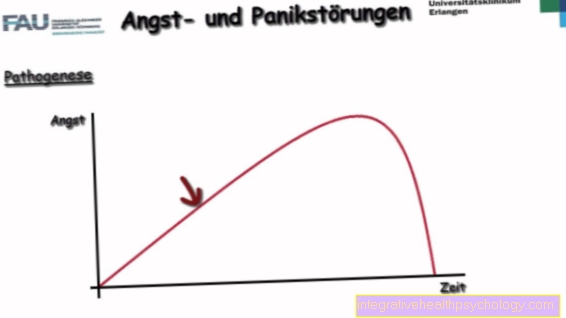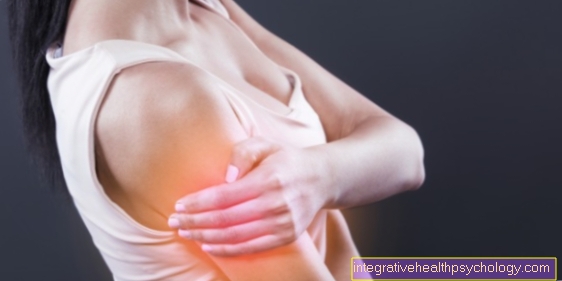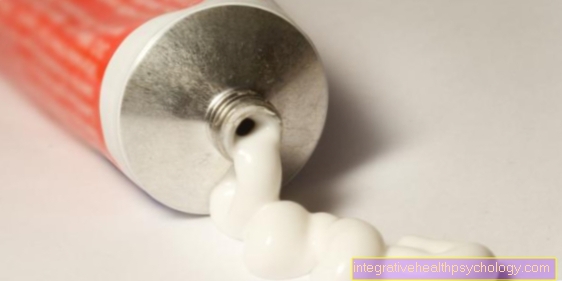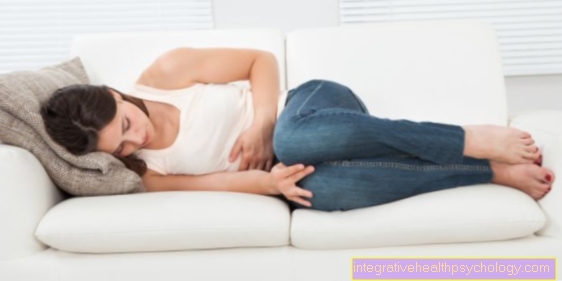Dizziness from the inner ear
Synonyms
Dizziness, dizziness, inner ear, vestibular apparatus
Balance disorder and dizziness
Since the dizziness triggered by the inner ear can always be traced back to a disturbance of the equilibrium organ, it is quite normal that the sense of balance is usually affected by dizziness.
The human sense of balance works through the cooperation of many participating centers. In particular, the coordination of the inner ear and the sense of sight, together with information from the body's sensation, is essential for a functioning sense of balance. The information from these centers is then processed by the brain and the movement required in each case is calculated in order not to topple over on a rocking ship, for example.

If one of the centers involved is disturbed, as is the case with dizziness caused by the inner ear, the brain can no longer bring the information together meaningfully. Since both inner ears only provide meaningful information about the position of the head in space if the inner ear is disturbed, it appears to us as if the world is constantly in motion, although we are standing still. The brain cannot combine this information and the balance is disturbed.
Also read:
- Dizziness and migraines - what is the underlying disease?
- Dizziness in old age
causes
So-called directed vertigo (often vertigo) is mostly due to a cause in the inner ear. Our equilibrium organ is located there (Vestibular organ), which is why dizziness through the inner ear is also referred to as vestibular dizziness.
The most common form is benign (benign) paroxysmal (seizure-like) positional vertigo, which is caused by small, loose crystals in the inner ear. Menière's disease can also cause dizziness in the inner ear. Inflammation of the inner ear can also lead to symptoms of dizziness. Other causes such as the perilymph fistula occur much less often.
Crystals in the inner ear - positional vertigo
The so-called otolith crystals play a very important role in the development of dizziness, especially in benign positional vertigo.These are part of the balance organ in the middle ear. The middle ear itself is filled with a fluid. In this liquid lie the otolith crystals on a dome-like organ. If the person now performs any form of movement, for example forwards or backwards, up or down, it happens that the dome-like organs with the crystals are deflected and register a movement. This is then passed on to the brain and processed there.
Due to external causes or simply in old age it can happen that the otolith crystals detach from their actual place. The problem here is not that the crystals are missing in place, but that they then get into the adjacent semicircular canal organ. This organ, whose job it is to register rotational movements, is now disturbed by the crystals floating around freely and sends illogical signals to the brain. This is how benign paroxysmal positional vertigo develops. With the help of the positioning maneuvers, the crystals can now be removed from the semicircular canal and the cause of the vertigo in the head can be eliminated.
Read more on this topic at: Positional vertigo
How do crystals come about?
The benign paroxysmal positional vertigo can be triggered by loose crystals in the inner ear. The crystals are naturally already in the inner ear, but are stuck there in different places. A sudden rapid movement can cause one or more of these crystals to loosen, so that they can then move freely in the inner ear. The movement of such a crystal in the inner ear means that movements in the organ of equilibrium are perceived that do not correspond to the movements of the rest of the body. As a result, the brain receives different signals and reacts with the symptom dizziness. As a rule, the dizziness caused by the crystals in the inner ear disappears as soon as the crystals have fixed again and are no longer free to move.
Cause inner ear infection
In case of inner ear inflammation (Labyrinthitis) the organ of equilibrium and hearing can become inflamed. Dizziness is triggered when the organ of equilibrium is also affected. Mostly bacterial or viral infections are the cause of the inflammation. In the case of an otitis media, these usually also get into the inner ear and damage the structures there.
An inflammation of the vestibular organ (equilibrium organ) leads to different information which the brain contains from the healthy and the sick equilibrium organ and can thus lead to severe dizziness.
Cause stress
Stress is a common cause of dizziness in general. Most of the time, however, there is no dizziness through the inner ear if the symptoms are caused by stress. Rather, vertigo is about excluding a cause in the inner ear. If nothing can be found there, other causes of the dizziness should be considered. The reason for the dizziness can, for example, be due to increased stress.
Read more on the subject at: Dizziness from stress
Cause circulatory disorder
Circulatory disorders of the ear can lead to temporary or permanent damage to the inner ear. If the organ of equilibrium (vestibular organ) is also damaged, this can lead to dizziness. If the cause of the dizziness through the inner ear is a disturbance of the blood circulation, this usually leads to unilateral damage to the organ of equilibrium. This gives the brain different information about the current position and movement of the body, which can lead to severe vertigo attacks.
Concomitant symptoms
The accompanying symptoms of dizziness through the inner ear vary in severity depending on the cause of the dizziness. For example, benign paroxysmal positional vertigo often leads to nausea and vomiting. In addition, the complaints usually only occur when the head is moved. Without physical exercise, the symptoms calm down.
In Menière's disease, on the other hand, there is typically a triad of symptoms (three symptoms occurring together). In addition to vertigo, this also includes sudden hearing loss (suddenly impaired hearing) and tinnitus (noise in the ear).
Other typical accompanying symptoms of dizziness through the inner ear can be headache. In addition, nystagmus can often be observed in affected people, with the eyes moving quickly back and forth, which occurs at the same time as the dizziness.
Read more on the subject at: Dizziness, nausea and headache
nausea
Nausea, usually together with vomiting, is a typical symptom of all types of dizziness and is therefore also common in dizziness through the inner ear. The nausea is particularly pronounced in benign paroxysmal positional vertigo. The dizziness occurs very suddenly after a small movement of the body or head, which causes an equally sudden feeling of nausea. It is not uncommon for those affected to vomit several times in a row.
Other forms of dizziness through the inner ear can also cause nausea and vomiting. They are mostly a reaction of the brain to the different sensory perceptions of the balance organ and the rest of the body. Nausea is also very pronounced in vestibular neuritis (failure of the organ of equilibrium on one side). Most of the time, if you are completely healthy, the symptoms are particularly sudden over several days.
Read more on the subject at: Dizziness with nausea - that's behind it!
These tests for dizziness caused by the inner ear are there
The anamnesis plays the most important role in diagnosing dizziness through the inner ear. By questioning the person concerned, the complaints and their cause can be narrowed down.
Special tests for dizziness through the inner ear can include examinations of standing and gait (also with eyes closed). Increased attention is paid to how severe the dizziness is and whether the affected person has a tendency to fall to a certain side. Also whether the vertigo is directed (always going in one direction) or undirected.
In addition, nystagmus (rapid twitching of the eyes when feeling dizzy) can be tested. This can be triggered at rest, with certain movements or only with the help of Frenzel glasses (glasses with very high prescription that prevent those affected from focusing on something in their surroundings with their eyes).
Read more on the subject at: Diagnosis of vertigo
treatment
Treatment for dizziness will, of course, depend on the exact causes. If, for example, the so-called benign paroxysmal positional vertigo is involved, simple positional maneuvers can help to treat the disease.
Affected people should sit upright, turn their heads to the side and then let themselves fall sideways on a soft surface (e.g. mattress, sofa). This sudden movement can move the free crystal to a fixed place in the inner ear so that it no longer causes any discomfort.
If nerve irritation is in the foreground, an infusion with cortisone along with agents that prevent nausea and nausea can provide relief. The cortisone should help with its decongestant effect and alleviate any pressure on the nerve. Blood thinning agents or agents that promote blood circulation are also used.
Anyone who permanently suffers from recurring dizziness should also receive physiotherapy. In the physiotherapy sessions, one can learn how to maintain everyday movement despite the dizziness.
Due to the very individual symptoms and fewer studies, there are hardly any generally binding therapy standards. Many methods from the field of alternative medicine are also supposed to help with dizziness. For example autologous blood therapy or enrichment with oxygen. Training and performing exercises are essential, especially if the dizziness persists. Through these measures, the brain learns to live with the existing stimuli, so that even if the cause cannot be remedied, the symptom of dizziness disappears.
Also read: Medication for dizziness
Exercises for inner ear vertigo
In the case of dizziness emanating from the inner ear, there are a number of exercises that can help eliminate the cause of the dizziness. This succeeds, for example, in benign positional vertigo. If the root cause cannot be corrected, balance exercises can still help the brain get used to the new situation. In this way, the stimuli that got mixed up when you were dizzy can be re-classified correctly.
Head and eye movements:
If you are very dizzy, you can start by letting your eyes wander to different points in the room. If this is possible without any problems, you can move the whole head and try out different angles of inclination and head postures.
Standing and walking training:
If possible, try to balance on one leg while standing. Standing still with straight legs and closed eyes is an exercise that is often difficult if you are dizzy. As an extension, you can also try to balance on special boards and thus improve the body's perception of space. Walking on an (imaginary) line or walking on tiptoe or on the heel help to improve coordination. Perseverance and repetition are particularly important in all exercises. Because only gradually does the brain learn to replace the faulty sensory stimuli with correct ones.
Positioning maneuvers:
In benign positional vertigo, certain positioning maneuvers help to remedy the cause of the vertigo. During the Semont maneuver, one sits on a couch or on the bed. Using the example of the right ear, the maneuver goes as follows. While sitting, the head is rotated 45 ° to the unaffected side, i.e. to the left. Now lie down quickly on the affected side, in this case the right side. After about 1 minute you now quickly change sides and lie exactly on the other side of the body. The position of the head is maintained all the time. It is important to change quickly and to keep the rotation of the head constant. It is normal for the dizziness to get worse when lying on your side. Another positioning maneuver is that according to Epley, but it is rather difficult to carry out it without a treatment couch.
You can find out more under our topic: Exercises for positional vertigo
homeopathy
Various homeopathic remedies can be used to combat vertigo through the inner ear. Depending on the underlying cause, various remedies are used: For example, Nux vomica can be taken in the event of dizziness with nausea and gag reflex. If the dizziness is made worse by exercise, one can resort to Bryonia. If ringing in the ears occurs in addition to dizziness, Cocculus can be taken as a homeopathic remedy. Lac defloratum can be taken against recurring vertigo.
Read more on the subject at: Homeopathy for dizziness
The organ of equilibrium

To the Balance organ in the Inner ear belongs to that vestibular Labyrinth, which also contains a bony labyrinth as a cavity system in which the actual sensory apparatus, the membranous labyrinth, is suspended. Of the Equilibrium apparatus (Vestibular apparatus) contains two macular organs (Macula sacculi and macula utriculi) and three semicircular canals, one anterior, one posterior, and one horizontal.
In a normal posture, the horizontal semicircular canal in the inner ear is raised by 30 °. The bony semicircular canals are arranged approximately at an angle of 45 ° to the main axes of the head.
The position of the semicircular canals is of clinical importance for thermal functional testing.
As mentioned, the horizontal semicircular canal in the inner ear is tilted forward by 30 °. If the head is raised by 30 ° when the patient is lying down, this semicircular canal is vertical. The thermal function test is used to examine the vestibular organs separately, as both organs are normally always excited.
To do this, one takes advantage of the density properties of the endolymph. If you rinse an ear canal with warm (44 ° C) or cold (30 ° C) water, the endolymph expands in warm water and rises upwards.
In response is a vestibular nystagmus (jerky eye movements, vestibulo-ocular reflex). This method is used, for example, at dizziness unclear cause.
Figure ear

A - outer ear - Auris externa
B - middle ear - Auris media
C - inner ear - Auris interna
- Ear strip - Helix
- Counter bar - Antihelix
- Auricle - Auricula
- Ear corner - Tragus
- Earlobe -
Lobulus auriculae - External ear canal -
Meatus acousticus externus - Temporal bone - Temporal bone
- Eardrum -
Tympanic membrane - Stirrups - Stapes
- Eustachian tube (tube) -
Tuba auditiva - Slug - Cochlea
- Auditory nerve - Cochlear nerve
- Equilibrium nerve -
Vestibular nerve - Inner ear canal -
Meatus acousticus internus - Enlargement (ampoule)
of the posterior semicircular canal -
Ampulla membranacea posterior - Archway -
Semicircural duct - Anvil - Incus
- Hammer - Malleus
- Tympanic cavity -
Cavitas tympani
You can find an overview of all Dr-Gumpert images at: medical illustrations
The semicircular canals in the inner ear continue to widen to form the ampulla with sensory epithelium (Cristae ampullares). It carries specialized sensory sensory cells embedded between supporting cells, the Hair cells. These essentially correspond to the structure of the snail's hair cells. You wear the finest Stereovilli and long Kinocilia. The tips of the longer stereovilli are connected to the next smaller villus. Here, too, is played again Transduction process in the Inner ear from. In the semicircular canals, the hair cells are oriented in such a way that the kinocilia all point in the same direction.
There is again in the sensory apparatus Endolymph fluidwashed by perilymphs. The composition resembles that of cochlear lymph. The endolymph spaces of the cochlear and vestibular labyrinth are above the Ductus reuniens in connection. The perilymph are about the Perilymphatic duct in the Subarachnoid space derived.
The semicircular canals perceive angular or rotational accelerations. So if we turn on a carousel, the information is provided from here as to the direction in which we are being turned. The principle of inertia is important here. There is a gelatinous mass over the sensory epithelium of the semicircular canals (Cupula) having the same density as that surrounding them Endolymph Has. However, this mass is connected at the upper end to the roof of the arcade wall. If the semicircular canals are now moved by rotational acceleration, the endolymph tries to stop. So the wall moves faster than the liquid for a moment. Since the cupula is attached to the wall, it is moved against the sluggish endolymph and flexed against the acceleration.
As mentioned, the vestibular labyrinth contains two more Macular organs. They measure linear acceleration, for example when braking and starting the car or when traveling in an elevator. So all up / down, forwards / backwards movements are measured here where a Dizziness can arise. Form the basis for this Calcite crystal inclusions (Otoliths, Ear stones), which have a higher density than the endolymph. This heavier otolith membrane slips over the sensory epithelium during linear acceleration and excites the hair cells. Since the macular organs are approximately perpendicular to each other, tension is always triggered in at least one sensory epithelium. As a result, we may not necessarily consciously perceive the constant force of gravity, but we can unconsciously be sure that we are standing upright in space.





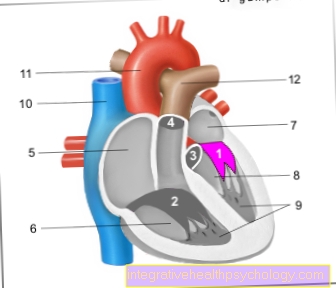
.jpg)
